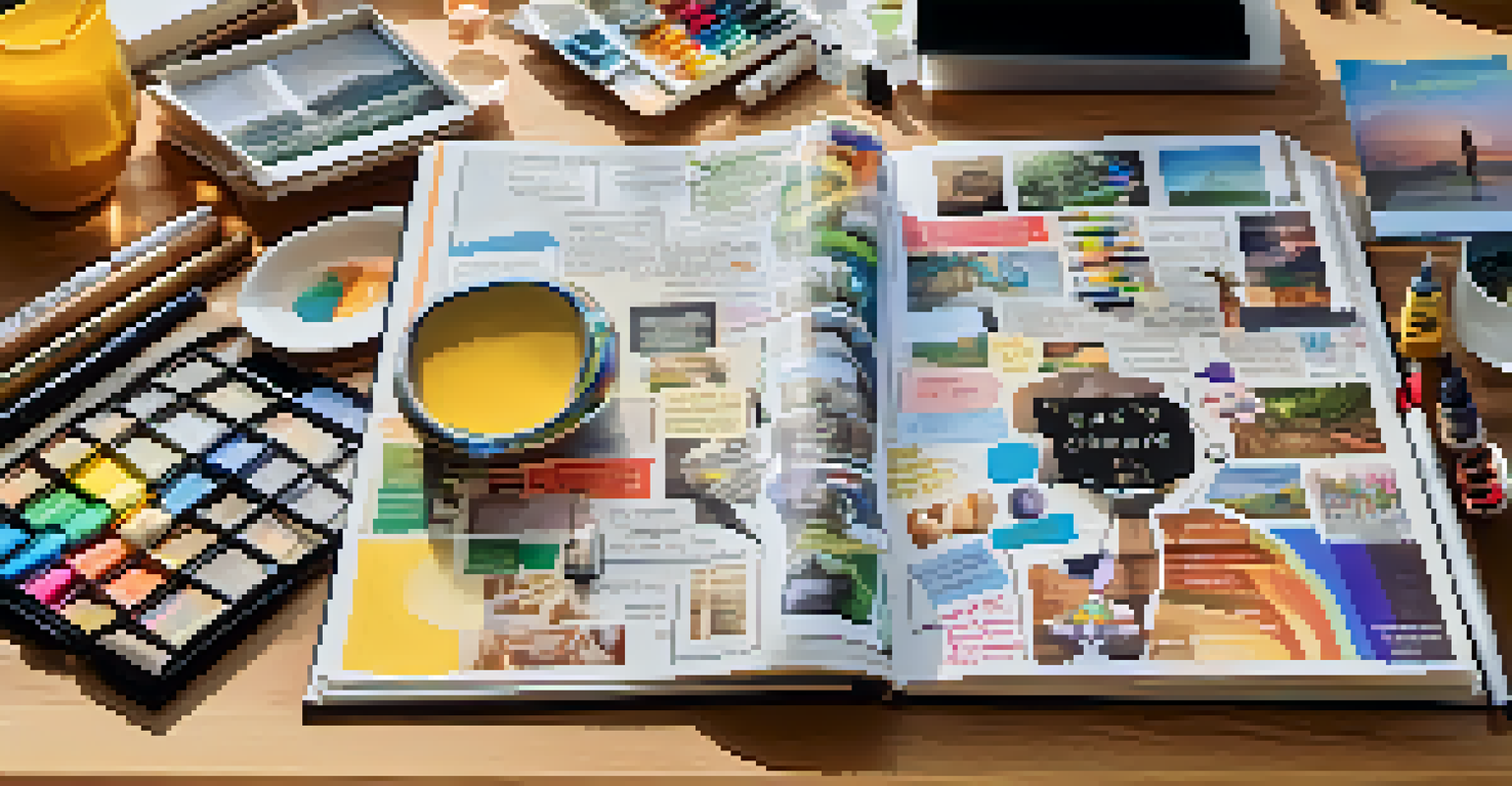The Role of Visualization Techniques in Healing

Understanding Visualization Techniques in Healing
Visualization techniques involve creating mental images to promote healing and well-being. They often tap into the mind-body connection, demonstrating that our thoughts can significantly affect our physical health. This practice can range from guided imagery to meditation, where individuals visualize positive outcomes or healing scenarios.
The mind is everything. What you think you become.
The core idea is that by picturing a desired state of health, individuals can foster a sense of empowerment and control over their healing journey. For instance, someone recovering from surgery might imagine their body healing quickly and effectively, which can enhance their actual recovery process. This approach helps in reducing anxiety and stress, making it a valuable tool in holistic healing.
Research has shown that visualization can stimulate brain activity associated with relaxation and healing. This means that the more vividly one can imagine a positive outcome, the more likely they are to experience it. In essence, visualization becomes a bridge between intention and reality, making it a powerful technique in the realm of healing.
The Science Behind Visualization Techniques
Numerous studies support the effectiveness of visualization in medical settings. For example, patients who practiced visualization reported less pain and anxiety during recovery. This is partly due to the brain’s ability to respond to imagined scenarios as if they were real, which can lead to actual physiological changes in the body.

Neuroscience research indicates that visualizing a task activates the same brain regions as physically performing it. This phenomenon is why athletes often use visualization to enhance performance; it primes the brain and body for success. Similarly, individuals facing health challenges can harness this principle to visualize their healing process.
Visualization Supports Healing
Visualization techniques can enhance the healing process by empowering individuals to create positive mental images of their recovery.
Moreover, these techniques can also lower cortisol levels, a hormone linked to stress, further aiding in recovery. By incorporating visualization into treatment plans, healthcare providers can offer a more holistic approach to healing that addresses both the mind and body.
Benefits of Using Visualization Techniques
One of the primary benefits of visualization is its ability to reduce stress and anxiety. By focusing on positive images and outcomes, individuals can shift their mindset away from fear and worry. This not only enhances emotional well-being but also creates a peaceful state conducive to healing.
Visualization is daydreaming with a purpose.
Visualization techniques can also enhance motivation and commitment to health goals. When individuals can see themselves achieving these goals through vivid imagery, they are more likely to take actionable steps toward their recovery. For example, someone overcoming a chronic illness may visualize themselves living a vibrant, active life, which can inspire daily choices that support that vision.
Additionally, these techniques can complement medical treatments, leading to better overall outcomes. Whether it’s through guided imagery before a procedure or daily visualization exercises during recovery, these practices provide an additional layer of support that can enhance traditional healing methods.
Practical Visualization Techniques to Try
There are several easy-to-implement visualization techniques suitable for anyone. One common method is guided imagery, where a practitioner leads individuals through a series of calming images. This can be done through recordings or live sessions, making it accessible for various preferences and needs.
Another technique is creating a vision board, which involves gathering images and words that represent your healing goals. Placing this board somewhere visible serves as a daily reminder of your intentions and aspirations. The act of curating these images can be a powerful way to engage the subconscious in the healing process.
Science Validates Visualization
Research shows that visualization can trigger brain activity that leads to physiological changes, helping to reduce pain and anxiety.
Mindfulness meditation is also an excellent way to incorporate visualization. By finding a quiet space, closing your eyes, and visualizing a serene place or a healing light enveloping your body, you can foster relaxation and positive energy. With practice, these techniques can become an integral part of your healing journey.
Incorporating Visualization into Daily Routines
Making visualization a part of your daily routine can amplify its healing effects. Setting aside just a few minutes each day for focused visualization can create a powerful habit. It can be as simple as spending a few moments each morning envisioning your goals for the day or imagining a peaceful scene to start your day calmly.
Another approach is to integrate visualization with other wellness practices, such as yoga or journaling. For instance, after a yoga session, spend a few minutes visualizing how your body feels at its best. This combination not only enhances physical movement but also reinforces your mental and emotional well-being.
Moreover, consider keeping a visualization journal. Document your experiences, feelings, and any shifts you notice in your health or mindset. This practice not only tracks your progress but also helps deepen your commitment to using visualization as a healing tool.
Challenges and Misconceptions in Visualization
While visualization techniques offer numerous benefits, some may encounter challenges or skepticism. One common misconception is that visualization is a 'magical' solution that guarantees healing without effort. In reality, while visualization is a powerful tool, it works best when used in conjunction with other healthy practices and treatments.
Another hurdle can be the difficulty some individuals face in visualizing clearly. It’s normal for beginners to struggle with creating vivid images in their minds. However, like any skill, visualization improves with practice. Starting with simple images or focusing on feelings rather than detailed scenarios can help ease this process.
Practical Techniques for Everyone
Simple methods like guided imagery and vision boards make it easy for anyone to incorporate visualization into their daily routine for improved well-being.
Lastly, it’s essential to approach visualization with an open mind and patience. Results may not be immediate, and that’s perfectly okay. Building a consistent visualization practice can lead to gradual changes, both mentally and physically, over time.
Success Stories: Real-Life Applications of Visualization
Many people have shared inspiring stories about the impact of visualization in their healing journeys. For instance, cancer survivors often report using visualization techniques to imagine their bodies fighting off tumors, which helped them feel more empowered throughout their treatment. These personal accounts highlight how visualization can transform one's mindset during challenging times.
Athletes also frequently utilize visualization to enhance performance and recover from injuries. By visualizing themselves succeeding in their sport, they build confidence and resilience. When injured, they might visualize their bodies healing and returning to peak performance, which often aids in faster recovery.

These success stories serve as powerful reminders that visualization isn't just abstract theory; it's a practical tool that can yield tangible results. Whether in sports, medical recovery, or personal growth, the application of visualization techniques can lead to incredible transformations, inspiring others to explore its potential in their own lives.